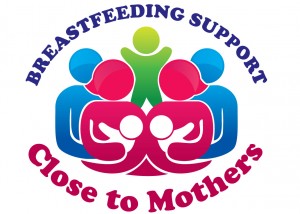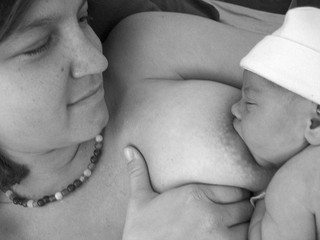July 31, 2013
Why Hospital Policies Matter: Study of California Hospitals Finds Birth Practices Impact Exclusive Breastfeeding Rates
By: Kathleen Kendall-Tackett | 0 Comments
Science & Sensibility, Lamaze International and our contributors are proud to support World Breastfeeding Week 2013, running August 1-7. The Sixth Healthy Birth Practice - "Keep mother and baby together- It's best for mother, baby and breastfeeding" stresses the importance of getting breastfeeding off to a good start. In honor of WBW, our next several posts will look at some of the recent research around breastfeeding. Today, Kathleen Kendall-Tackett shares research on how the place of birth impacts breastfeeding rates. - Sharon Muza, Community Manager, Science & Sensibility
 A recent study in California found that exclusive breastfeeding rates vary tremendously from hospital to hospital. If a mother is planning to breastfeed, where she gives birth makes a difference. For example, the rate of exclusive breastfeeding may be 90% in one hospital, while only 10% in another. (Maternity Care Matters:Overcoming Barriers to Breastfeeding, 2012)
A recent study in California found that exclusive breastfeeding rates vary tremendously from hospital to hospital. If a mother is planning to breastfeed, where she gives birth makes a difference. For example, the rate of exclusive breastfeeding may be 90% in one hospital, while only 10% in another. (Maternity Care Matters:Overcoming Barriers to Breastfeeding, 2012)
Unfortunately, hospitals with the lowest exclusive breastfeeding rates are often those that serve low-income and ethnic minority women. For many years, policy makers assumed that low rates of breastfeeding in ethnic-minority populations were due to "cultural differences." We have since learned that this is not the case.
Breastfeeding Policies Make a Difference
In 2010, the Joint Commission included exclusive breastfeeding as part of its core perinatal measures. To increase exclusive breastfeeding rates, hospitals need policies that ensure that women have access to skilled breastfeeding support. In addition, breastfeeding policies need to stipulate that staff avoid separating mothers and babies, delaying first feeding, and supplementing with formula unless there is a medical reason. But many hospitals are falling far short of this standard. According to the 2009 mPINC (Maternity Practices in Infant Nutrition and Care) national survey, 91% of hospitals were providing breastfeeding education, and 88% were providing breastfeeding advice and counseling. However, only 31% of hospitals offered postpartum support and 21% had a written breastfeeding policy. In addition, 78% were regularly using formula. (Maternity Care Matters: Overcoming Barriers to Breastfeeding, 2012)
Birthing Practices Also Impact Breastfeeding
Birthing practices, such as cesarean sections or elective inductions, can also lower rates of exclusive breastfeeding. At some hospitals, these procedures are rare. At others, they are commonplace. For example, the Maternity Care Matters report compared two hospitals in California, and found that one hospital had 10 times the rate of early elective inductions as the other.
Cesarean sections are another birth practice that can impact breastfeeding. From 1998 to 2008, cesarean births in California increased by 50%. These rates also varied by hospital, ranging from 9% at one hospital to more than 50% at another.
Early elective delivery of infants (37 to 38 weeks gestation) also rose in California by 47% from 1990 to 2006. This practice contributes to a number of serious health problems for infants. In fact, this type of birth is so high risk that the California Maternal Quality Care Collaborative, in partnership with the March of Dimes, has developed a tool kit to help administrators curb this dangerous practice.
For many mothers, a high-intervention birth, combined with inadequate breastfeeding support, compromises breastfeeding in the early days of life. In summary, the California WIC Association and the UC Davis Human Lactation Center note that many birthing practices, which some hospitals consider routine, are not necessary and do not meet current standards of care. (Maternity Care Matters:Overcoming Barriers to Breastfeeding, 2012
Hospital policies and practices - from elective procedures to formula supplementation - that do not directly support the health of mothers and babies are not only outdated, but they fail to reflect what is now considered standard, high-quality care.
So what can hospitals do to increase the rate of exclusive breastfeeding, thereby improving the health of both mother and baby?
Recommendations
1. Have Written Breastfeeding Policies and Train Staff
The WIC/UC Davis Report recommended several specific policy changes to increase exclusive breastfeeding. These policy recommendations include monitoring hospitals that have high rates of supplementation and low rates of exclusive breastfeeding, with an eye towards improving their maternity practices. The Report strongly encourages hospitals to have written breastfeeding policies, and train their staff in breastfeeding support, consistent with the first two steps of the Baby-Friendly Hospital Initiative (BFHI).

© http://flic.kr/p/5f29EK
The BFHI also includes prenatal education about breastfeeding, initiating breastfeeding in the first hour after birth, showing mothers how to breastfeed or maintain lactation when separated from their infants, avoiding supplementation unless medically necessary, rooming in, unrestricted breastfeeding, no artificial teats/nipples, and community breastfeeding support. Research has demonstrated that these recommendations increase exclusive breastfeeding, even in groups designated as "high risk." (Merewood, 2005)
A study from Boston Medical Center, which became a Baby-Friendly Hospital in 1999, demonstrated the impact of the BFHI on breastfeeding rates for African American women: 34% in 1995, 74% in 1999. (Philipp, 2001) Another study found that, "Among a predominantly low-income and black population giving birth at a U.S. Baby-Friendly hospital, breastfeeding rates at 6 months were comparable to the overall U.S. population." (Merewood, 2007)
2. Avoid Unnecessary Interventions During Labor
Hospitals vary widely in the percentages of cesareans, elective inductions, and elective early deliveries. All of these interventions increase women's risk of PTSD following birth (Kendall-Tackett, 2013) and can potentially have a negative impact on breastfeeding. Some of these procedures may be medically necessary. But many are not, and are done for doctor or patient convenience.
If our maternal outcomes were good, perhaps we could conclude that these practices are saving mothers' lives. But our maternal mortality rates are not good, and in fact have nearly doubled since 1987. Moreover, there is a huge racial disparity in maternal mortality: the rate for African American mothers is triple the rate for whites. (Huffington Post, 2012)
The WIC/UC Davis report explicitly states that "poor maternity care means poor breastfeeding outcomes." If we want to increase our breastfeeding rates, we must address birth. In fact, we need to ensure that birth is not only baby friendly; it needs to also be mother friendly.
In conclusion, the World Health Organization and American Academy of Pediatrics recommend exclusive breastfeeding for the first six months of life. Unfortunately, many babies in American hospitals receive formula supplements during their time in the hospital. Early supplementation, combined with lack of community support, means that many mothers fall far short of their breastfeeding goals. High-intervention birthing practices can also undermine breastfeeding, particularly when mothers do not receive skilled breastfeeding support in the hospital or in their communities. Fortunately, hospitals can turn this around by implementing policies that are good for both mothers and babies. Maternity Care Matters summarizes it as follows: Breastfeeding support is an essential part of high-quality maternity care.
And to be truly effective, breastfeeding support needs to start before birth.
References
California WIC Association and UC Davis Human Lactation Center. Maternity Care Matters: Overcoming Barriers to Breastfeeding; 2012 Annual California Fact Sheet. http://calwic.org/storage/restricted/hospitalreport/Maternity%20Care%20Matters_2012.pdf
Fact Of The Day #26: Maternal Mortality Rate Rising Despite Expensive Care (INFOGRAPHIC). (2012, August 24). Retrieved July 30, 2013, from http://www.huffingtonpost.com/2012/08/24/maternal-mortality-rate-infographic_n_1827427.html
Kendall-Tackett, K. (2013, June). Science & Sensibility » Childbirth-Related Psychological Trauma: It's Finally on the Radar and It Affects Breastfeeding. Retrieved July 2013, from http://www.scienceandsensibility.org/?p=6821
Merewood, A., Mehta, S. D., Chamberlain, L. B., Philipp, B. L., & Bauchner, H. (2005). Breastfeeding rates in US Baby-Friendly hospitals: results of a national survey. Pediatrics, 116(3), 628-634.
Merewood, A., Patel, B., Newton, K. N., MacAuley, L. P., Chamberlain, L. B., Francisco, P., & Mehta, S. D. (2007). Breastfeeding duration rates and factors affecting continued breastfeeding among infants born at an inner-city US Baby-Friendly hospital. Journal of Human Lactation, 23(2), 157-164.
Philipp, B. L., Merewood, A., Miller, L. W., Chawla, N., Murphy-Smith, M. M., Gomes, J. S., Cimo, S., & Cook, J. T. (2001). Baby-friendly hospital initiative improves breastfeeding initiation rates in a US hospital setting. Pediatrics,108(3), 677-681.
Tags
Breastfeeding Childbirth education World Breastfeeding Week Labor/Birth Newborns Maternal Infant Care Babies Kathleen Kendall-Tackett Guest Posts